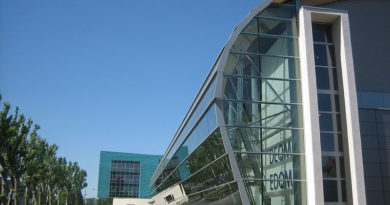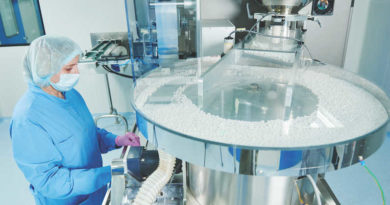
The pandemic presents an opportunity to recolour industry green
The next decade is our last chance to avoid the most catastrophic consequences of climate change. We need to act now, and the COVID-19 pandemic provides us with an opportunity to do so.
As a result of the pandemic, there is unique political momentum for joint, decisive action of the kind needed to implement the European Green Deal, with its aim of a net-zero carbon continent by 2050 and growth decoupled from resource use. We need to use this opportunity to make sure the EU’s recovery programme supports a recovery that is green and smart. This would lay the foundation for a fair future and strong, competitive European industry, which leads in technology and green transformation.
Where does the transformation begin? The industrial sector produces about one-quarter of global GDP and employment. Energy-intensive industries, such as steel, chemicals and cement, are important to our economy and many of our strategic value chains. However, our industrial activities also produce large amounts of greenhouse gases. Roughly 25% of the EU’s greenhouse gas emissions come from industry. That is why the decarbonisation and modernisation of industry will be crucial to reaching our climate targets.
The extent to which industry can benefit from and contribute to a climate-neutral future will largely depend on its ability to scale new solutions, implement existing technologies, and continue to develop and commercialise new products and breakthrough technologies.
Our capacity to innovate will be critical.
Although significant cost reductions and fast adoption of renewable energies such as solar, wind and energy storage have transformed the energy landscape in recent years, carbon-neutral energy often remains two or three times more expensive than fossil-sourced energy. Many technologies needed for deep carbonisation, such as low-carbon, hydrogen-based production of steel and chemicals, are not scalable yet. In others cases, solutions are technically viable but economically challenging. High capital costs, lack of incentives or revenue models, long payback times and high project risks are just some of the factors restricting green investment.
That is why we need to further develop and deploy innovations such as new low- carbon production technologies (e.g. low carbon cement, hydrogen-based chemicals and newer approaches to steelmaking), a comprehensive circular economy, material efficiency along the value chain, CO2-free secondary energy carriers (electricity, synthetic methane and hydrogen) and use more biomass or carbon capture solutions. We also need to invest more in digitisation and big data to unlock further untapped potential for a greener industry.
Pursuing these multiple technological pathways is a daunting challenge, and it will not be cheap. According to McKinsey, the global decarbonisation of industry will cost between $11 trillion and $21 trillion by 2050. Meeting the EU target of net-zero carbon emissions by 2050 will require annual investment in the decarbonisation of industry between €40 billion and €140 billion (roughly 0.2% to 0.8% of EU GDP).
But Europe is not doing enough to support innovation.
Every year for the past 15 years, the EU has invested around 1.5 percentage points of its GDP less in research, development and innovation than our main competitors from the USA, China and South Korea.
And contrary to our ambition to lead cleantech, we only invest €7.5 billion a year in climate-related research and development. That’s considerably less than the USA with €12 billion, or China with €8.6 billion. The pandemic is also taking its toll on RDI investment in Europe.
If we want Europe to be influential and powerful enough to safeguard our values and prosperity, we need to pioneer and lead technology and innovation. Developing technologies before anyone else does keeps industrial production in Europe (and thereby millions of jobs) even as the cost of CO2 steadily rises. Europe’s technologically advanced position in high emitting industries such as steel manufacturing, chemicals and cement also provides an opportunity to lead global decarbonisation. Once the feasibility of technologies is proven at scale in Europe, industrial decarbonisation is also more likely to accelerate on a global level. That’s to the benefit of all.
It is unclear which technologies will prevail. Industry thus faces multiple possible decarbonisation pathways. According to most researchers, no single solution will be able to achieve complete decarbonisation on its own.
This situation poses a huge problem, as companies adopt a wait-and-see attitude and tend to stall investment. Even worse, some continue to rely on and invest in proven, yet unsustainable solutions. Around 80% of firms are postponing or cancelling planned investment due to a perception of high uncertainty on the markets.
Moreover, for many businesses cutting emissions is associated with an expensive and typically inconvenient burden that will mostly benefit others or future generations. Whereas the benefits accrue over decades and centuries, the costs must be paid upfront.
Consequently, many innovations are not progressing fast enough. We need to accelerate their deployment and commercialisation, and boost the development of new disruptive technologies and services at the same time. We need investments that drive down technology costs, increase efficiencies, support first movers, and create new markets.
In this context, multilateral financial institutions, like the European Investment Bank, can play a crucial role in enabling the private and public sector to invest more in innovation and green technologies. As the EU’s climate bank, the EIB Group aims to unlock more than EUR 1 trillion of climate action and environmental investment over the next decade.
By providing patient, long-term financing and taking a part of the investment risk, the European Investment Bank can help to develop a more predictable market environment for new low-carbon technologies and help companies explore uncharted territories.
We have developed a wide range of innovative financial instruments and advisory services—often together with national partners—that can support the full range of innovation activities and actors, from university spinouts, start-ups and first-of-a-kind demonstration plants to large-scale corporate projects. As such, the European Investment Bank acts as an incubator, sheltering technologies and new business models, and enabling the creation, survival and growth of comprehensive technological and sustainable alternatives.
A recent example of our support for industrial innovation is Northvolt, a Swedish battery manufacturer. Our €52.5 million loan supported Northvolt’s battery manufacturing
demonstration plant. The 125MWh Li-ion batteries Demonstration Line had the dual purpose of validating the technical feasibility and viability of the proposed production techniques and acting as a development and research facility. The successful demonstration project was key to launching Europe’s first homegrown giga factory for lithium-ion battery cells, Northvolt Ett, in Sweden in July 2020. The European Investment Bank also backed the giga factory with a EUR 300 million loan.
Another example is a €75 million loan to support carbon capture and usage as well as a bio-coal demonstration project in a steel plant in Belgium. The project could produce considerable amounts of ethanol through using off-gases from primary steel manufacturing, a greenhouse gas emissions-intensive process, and substituting bio-coal from waste wood for fossil coal. The aim is to demon- strate the technical feasibility and viability of these proposed technologies at full industrial scales.
In addition to projects, the EIB also backs broader initiatives for the EU industry such as the European Battery Alliance and most recently the European Raw Materials Alliance.
This new alliance is part of the European Commission’s Action Plan on Critical Raw Materials and aims to reduce Europe’s dependency on non-energy raw materials for industrial value-chains. Access to sustainable raw materials is crucial if Europe wants to continue to play a leading role in the entire value chain of innovative low carbon technologies. We therefore need to pursue better material recycling and circular economy principles as well as innovative solutions to reduce primary material usage, substitute critical raw materials and improve efficiency in extraction. The EIB will continue to make a difference in these areas and mobilise financing, including via risk-sharing instruments.
The transformation to a low-carbon industry requires investment in fundamental technology change. We need to accelerate the technological change to make the transition to a greener industry possible in the time we have left.
Europe now has a unique chance to take decisive action. We need to use the momentum of the recovery plan to accelerate the green transformation of Europe’s industry while ensuring its competitiveness. Public institutions such as the European Investment Bank can play a crucial role by enabling and accelerating investment.




